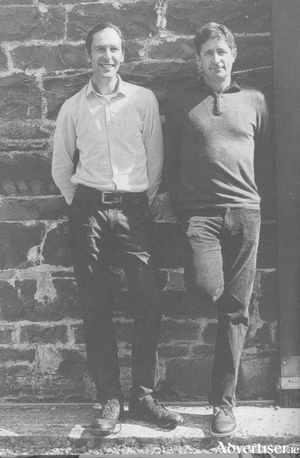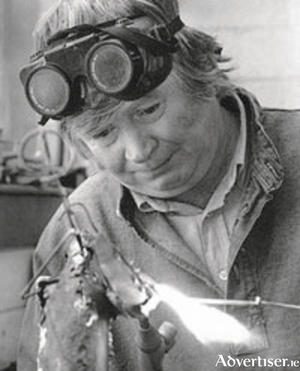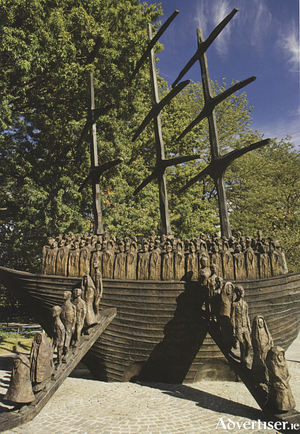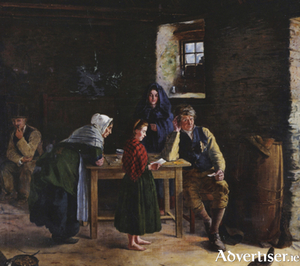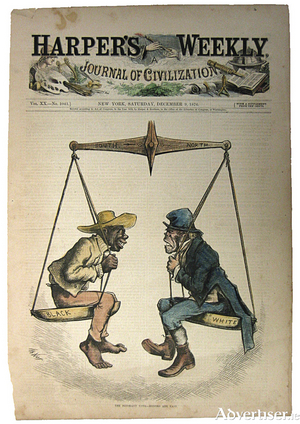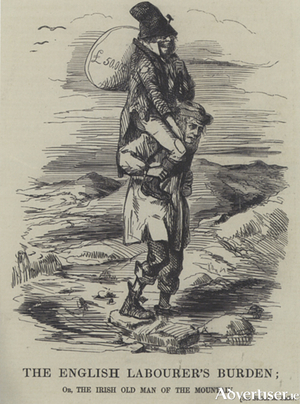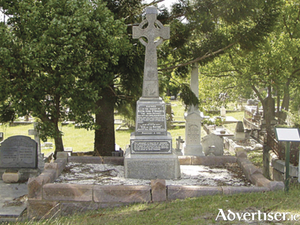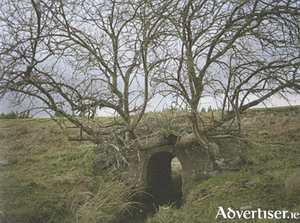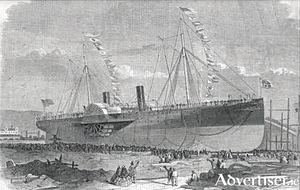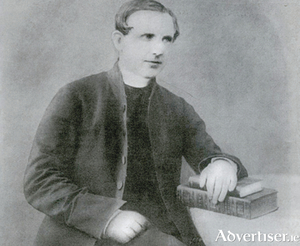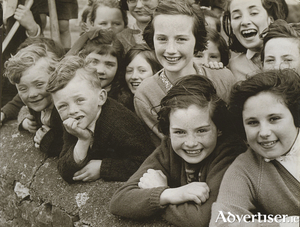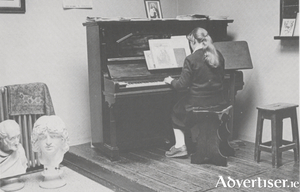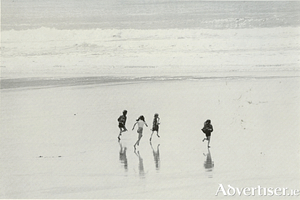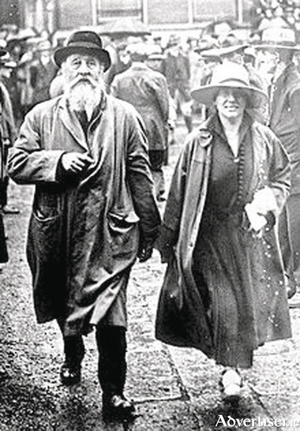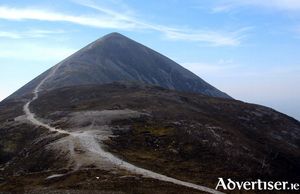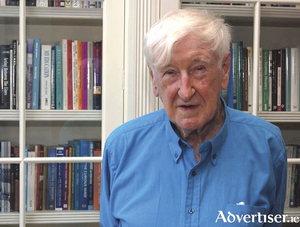The Sheridans, and the ‘human connection to our land’
Thu, Nov 26, 2015
One of the great business success stories in Galway has to be the rise and rise of the Sheridan brothers, who began selling cheese from a small stall at the Saturday market, to become a national brand, with products selling in major British food stores, and across the continent.
Read more ...The Bull of Sheriff Street
Thu, Nov 19, 2015
Artists can be very awkward at times. They don’t always conform to decisions made on their behalf. They rarely behave nicely if they disagree with authority.
Read more ...‘Something better could be found’
Thu, Nov 12, 2015
The Great Famine of 1845-51 was, the Galway historian Gearóid Ó Tuathaigh tells us*, ‘a subsistence crisis, and a social calamity without parallel in the 19th century. It resulted in more than 1,000,000 dying of starvation and related diseases; and it ‘precipitated a virtual tidal wave of emigration that would see 4,000,000 flee the country during the following 20 years’.
Read more ...‘The keystone of fortune is the power of speaking English’
Thu, Nov 05, 2015
Whatever about the discrimination against the Irish emigrants in both Britain and America as they fled the ravages of the Great Famine in the mid 19th century, the effect of gaining a foothold in the two major English speaking countries of the world, pretty much sounded the death knell for the Irish language.
Read more ...How America hated the Irish exodus
Thu, Oct 29, 2015
When Charles Dickens first visited the United States in January 1842, the popularity of his books was such that he was mobbed by adoring crowds, feted and dined as the major celebrity that he undoubtedly was, and was guest of honour at a famous Valentine’s Ball in New York attended by 3,000 of the city’s great and good.
Read more ...A time when the Irish were not welcome
Thu, Oct 22, 2015
Between the years 1845 and 1855 more than 2.1 million people emigrated from Ireland. They streamed into Liverpool, Manchester, Boston and New York. Many were diseased, hungry, dirty, broken spirited, with barely any personal belongings. Some embarked actually naked.
Read more ...A letter from Seamus Heaney
Thu, Oct 15, 2015
Irish traditional music is one of the great survivors of history. Maybe it was because we are an island, way off on our own in the western Atlantic, and until the latter decades of the last century, out of hearing from the mass cultural movements of popular cinema, radio and TV, especially the modern music from Europe and the US, that something distinctive has survived. As a boy I would only hear traditional music sessions in a few Gaelteacht areas, or from the welcoming Standún family in Spiddal, or at the Féiseanna at An Taibhdhearc, which was more memorable for the day off from school than it was for the music.
Radio Éireann played traditional music at times, but my memory is that the airwaves were dominated by the sentimental singing of people like Delia Murphy, known as the Queen of Connemara, and her If I were a blackbird, which seemed to have been played endlessly.
Read more ...An Unusual connection between Breaking Bad and ‘Eva of the Nation’
Thu, Oct 08, 2015
Most of us are mad jealous that we cannot claim some kind of connection with Caherlistrane. A new book by Mary J Murphy* manages to link the north Galway parish with an extraordinary number of writers, artists, singers, poets, actors, and historical personalities, that leave all other parishes in Ireland bereft of personality and character. There can be no other competition. We are all characterless by comparison to Caherlistrane.
Read more ...‘A ghostly presence through trees and over bog’
Fri, Oct 02, 2015
One of Ireland’s great engineering feats in the 19th century was the building of the Galway - Clifden railway. After 30 years of argument as to which was the best route, the first train steamed out of Galway to Oughterard on January 1 1895; and the final section to Clifden was finished by July of that year.
Read more ...One war that Fr Conway lost
Thu, Sep 24, 2015
Before Fr Peter Conway was appointed parish priest of Headford, he was a curate in Ballinrobe. His very considerable energies were thrown into building a new church and presbytery. He also succeeded in acquiring a site for the Convent of Mercy and Christian Brothers’ schools in a primary location in the centre of the town. And all may have been well, and the good father praised for his building and organisational skills, and allowed to live in peace, were it not for the Mayo general election of April 6 1857.
Conway became obsessed, going way beyond the bounds of respectability in his use of descriptive language, his threats of hell and damnation, even using intimidating terror gangs and physical force to support the Catholic George Henry Moore who was being seriously challenged by two powerful and wealthy Protestant landlords Rodger W Palmer and George Gore Ouseley Higgins.The outgoing member for parliament was the hard working, but vehemently anti Protestant, George Henry Moore, of Moore Hall, Ballyglass, Co Mayo. He spent a good deal of his first decade as MP for Mayo calling for the disestablishment of the Church of Ireland.
Read more ...‘God grant peace to America’
Thu, Sep 17, 2015
Despite Fr Peter Conway’s row with the Protestant rector of Headford, the Rev Dean Plunkett (and there were some appalling battles against Protestants to come), he got on surprisingly well with the landlord of the whole area, the impressively named Richard Mensergh St George, Esq, also the High Sheriff. Initially, when Conway asked him if he would donate land for a church for his Catholic tenants, the request was turned down flat. But out of the blue, St George invited Conway to his house one day and offered him an acre of ground ‘anywhere on his estate’, rent free forever; furthermore, he gave an additional seven acres of land for a priest’s house, and a subscription of £20 for a school.
Read more ...The young priest who cried for two days in Carna
Thu, Sep 10, 2015
I hope the recent scandals in the Catholic Church will not discourage the noble tradition of the cleric as the social champion of the people. It is time that we had their like to nail their colours to the mast once again. Growing up in the last century, I was familiar with such names as Fr James McDyer and his tireless campaign against the official neglect of Gleann Cholm Cile; and Canon George Quinn and his fight for better social housing. There were several others, who have spilled over into recent years, including Fr Peter McVerry and his fight for homeless people in Dublin, and Fr Harry Bohan and his belief in the staying power of families in rural Ireland. But the champion of them all, the priest with the soft voice and a twinkle in both eyes, was the indefatigable Monsignor James Horan. Not only did he re-design the village of Knock to make it more people friendly, he built schools, clinics, and a convent, and a vast basilica. He organised community water schemes, and forestry plantations, and built an impressive international airport in the bogs of Mayo.
Read more ...Kevin Curran’s introduction to the oil business
Thu, Sep 03, 2015
Perhaps only Ladies Day at the races causes a similar frenzy to all the upset and commotion that heralds ‘Back to School’ at the end of August or beginning of September. It is the biggest event in the social year. After the long summer holiday children are in a daze as their parents lead them, often dressed in new clothes top to toe, forward into the yard. If it is their first day at school, mum or dad will linger for a while in the classroom, intimidated by the confidence of the young múinteoir, the small tables and chairs, the 57 varieties of slippers, and the smell of pencils and paint. They leave consumed by their own memories.
Read more ...Portrait of a Galway writer
Thu, Aug 27, 2015
During the past few weeks I have tried to give some of the formative influences on the life of the writer Eilís Dillon as she grew up in Galway. The impact of her parents’ (Professor Tom Dillon and Geraldine Plunkett) commitment to the War of Independence, and her nightly fears of sudden raids on their home by the Black and Tans was a nightmare that stayed with her all her life.
Her uncle Joseph Plunkett’s execution after the 1916 Rising, and his marriage to Grace Gifford only hours before his death, deeply traumatised the family. Miss Gifford, who had converted to Catholicism, was ignored by the Plunketts. She had to issue court proceedings to secure her share in her late husband’s estate. Eilís’s mother, Geraldine, described Grace as a ‘ loner, and often very difficult’.
Read more ...Baron Corvo’s short visit to Sligo school
Thu, Aug 20, 2015
I am sure that the good sisters at the renowned Ursuline convent school, Sligo, had no idea what they were letting themselves in for when Eilís Dillon and her sisters landed as boarders at their door. The Dillon girls were confident, challenging and extremely well read. Much of that confidence came from their fiercely nationalistic mother and father and their commitment during the War of Independence. Both parents were imprisoned; their father, Professor Tom Dillon, was ‘on the run’ for most of that time.
Read more ...Barna - And a Grecian princess
Thu, Aug 13, 2015
The Dillons were a well known and respected family in Galway. It was put about that it was his determination that his five children should have a thorough knowledge of the Irish language, that led professor Tom Dillon, and his wife Geraldine (Plunkett), and their two maids, to leave the rambling Dangan House, and to settle in Barna, a small Irish speaking fishing village, four miles on the other side of the town.
Read more ...A young girl carried the scars of war
Thu, Aug 06, 2015
In an attempt to bring some normality into their lives following the traumatic years of the War of Independence, and the Civil War, Professor Tom Dillon, and his wife Geraldine (nee Plunkett), moved their five children to Dangan House, about three miles north of Galway town, close to the River Corrib. It is now a flourishing garden nursery, run by the busy Cunningham family and staff, but in the late 1920s it was a rambling two-storeyed manor house with shallow steps leading to a wide front door. Their father bought a cow, and chickens ran wild in the yard. In many ways it was an ideal home to bring up a lively young family, but understandably the terrors and the residue of those early years still bore heavily on the children. Politics was still a dominant player in their lives.
Read more ...‘The mountain is just a way of thinking’
Thu, Jul 23, 2015
Next Sunday, the last Sunday in July, is Reek Sunday which celebrates the national pilgrimage to Croagh Patrick, Ireland’s Holy Mountain. Several thousands of people are expected to make the arduous climb, which can take over two hours to get to its summit. If it’s a clear day the views across Connemara, and along the coast line, are spectacular. If the climb is made in misty weather, then it becomes an adventure of another kind. Whatever the weather there is a real sense of camaraderie, and shared humanity; a feeling too that to take a few hours out of our busy lives, to concentrate on the effort of the climb, and support our fellow travellers, is ‘to experience a life time in miniature.’
The Rev Gary Hastings, in his new book Going Up The Holy Mountain,* accepts that an increasing number of people have no idea about the concept of pilgrimage. They regard the whole thing as something quaint, superstitious and irrelevent. That perception, he believes, is wrong. To make a pilgrimage, even a long walk, or to climb any mountain, is a useful device to have in our ‘spiritual toolkit’. He invites the reader to climb Croagh Patrick, and provides a generous spiritual guide as to how that climb can become meaningful. Climbing the mountain ‘involves concrete action and movement. It is not shrouded in words and theology; it is something you just do. And while you do it, things can change. You leave yourself open to possibility, to the chance of hearing the silence, seeing the meaning.’
Read more ...An invitation to climb Croagh Patrick
Thu, Jul 16, 2015
Sunday week, July 26, is Reek Sunday, or Garland Sunday or Garlic Sunday or even Crom Dubh Sunday, and I am sure there are many other names to describe the famous pilgrimage to Croagh Patrick, when many thousands climb to its rocky summit.
Read more ...A poet at Claregalway castle
Thu, Jul 09, 2015
Once upon a time, when a renowned bardic poet visited the castle a sort of hysteria broke out. Women ran to the kitchens to prepare hogs and stuffings for a great feast. Banners and flags were flown from the battlements. Musicians urgently practiced new songs in his praise. Tavern keepers rolled in their best barrels of beer and wine, and weapons were nosily discarded. All prisoners and lunatics were released. Fathers were invited to bring to the fore their young daughters, so that they may be admired!
Read more ...